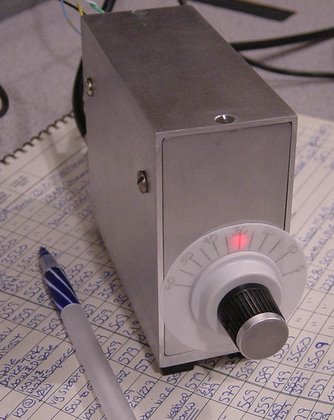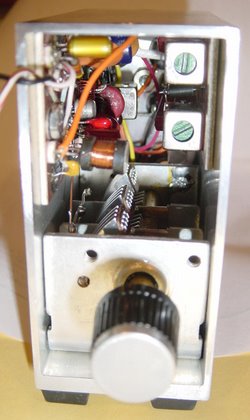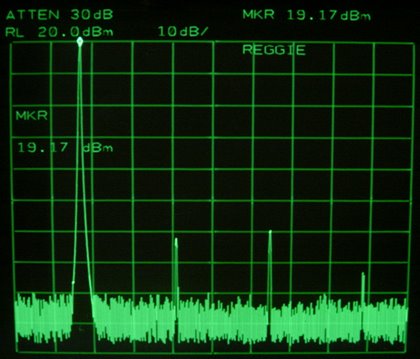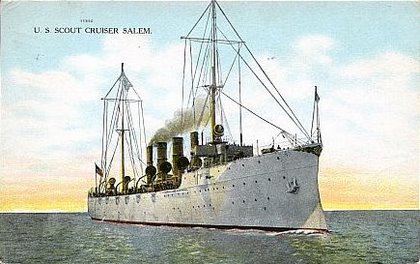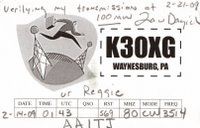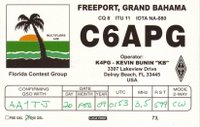Reggie is a one-transistor, 80m, QRP transceiver designed for the minimalist. It's a "dual-action" QRP radio; not only does it transmit a small signal, but the receiver converts every signal on the band into QRP.
- ~ 100mW output power
- Fessenden heterodyne receiver
- Tunes from 3503 to 3563kHz
- Full QSK
- RIT
- "Chirpless" keying
- Clean output signal
I've named this radio in commemoration of the great Canadian radio pioneer, Reginald Fessenden.
Transmitter
One-stage transmitters share a common difficulty; the necessity for clean keying generally limits their operation to quartz crystal-control on the lower bands. While it is possible to "rubber" the crystal, in order to retain reasonably good keying the total frequency excursion for each crystal is severely limited.
I recently found myself wondering if it might be possible to escape this limitation. The design offered in Reggie represents my solution. It's a simple idea that hearkens back to the earliest days of radio. The oscillator runs continuously. While the transceiver is receiving the oscillator delivers most of it's power into a dummy load, with the remainder used to feed the receiver BFO. When the key is depressed this RF energy is re-routed to the antenna via a simple switching network comprised of a pair 1N4007 rectifiers. This technique allows a wide-range, ceramic resonator VXO to be used as a single-stage CW transmitter without the disadvantage of keying chirp.
The VXO is a standard Colpitts oscillator. A forward-biased LED provides a stable DC bias to the base as well as the back-light for the tuning dial. The values of the Colpitts feedback-divider capacitors - C3 and C4 - are made large in order to "swamp" the capacitances external to the ceramic resonator. I used an FT50-43 core at T1 only because that's what I had in my junk box. The collector DC input power at Q1 measured 300mW. This indicates an efficiency of approximately 28%.
With VC1 set at the middle of the frequency span, and with the key-up, adjust the slug at T2 to peak the oscillator signal at the 2-turn link. Now, re-adjust this slug until the oscillator frequency (measured at the T1 secondary) drops by 600Hz on key-down. The idea is to create the RIT by deliberately mis-tuning T2/C6 in order to increase the oscillator load (as compared with the antenna) while receiving. In my prototype, an RIT setting of 600Hz at mid-range (3540kHz) produced an offset of 608Hz at the bottom, and 557Hz at the top of the frequency range.
Please bear in mind that you don't have to use a transistor ceramic resonator VXO in this radio. I'd like to build a second Reggie transceiver for 40m using a subminiature triode, permeability-tuned-oscillator (PTO), utilizing the "brass-screw" tuning-trick. The keying method used in Reggie ought to allow even a VFO to key cleanly. However, if you increase the oscillator output power be sure to increase the bias voltage at the 1N4007 keying diodes, and be careful not to overdrive the receive mixer diodes.
The circuitry is built "Manhattan-style." The main circuit is mounted to the left-hand bulkhead in the above photo, while the input/output bandpass filter is affixed to the upper right-hand wall. The variable capacitor was salvaged from an old FM radio. It has a 6:1 ball-reduction mechanism built into the shaft. The extruded aluminum enclosure is a waste off-cut, taken from a section of overhead cable-tray used at the television station where I work. The narrow rectangular shape helps to conserve my limited shelf space.
The harmonics are down by at least 59dBc at an output power of 83mW.
Receiver
Reggie is outfitted with a Fessenden heterodyne receiver; a continuation of my experiments from last winter. A simplified version of the mixer used in my Das DereLicht Receiver directly drives a pair of ST-3 headphones made by the Japan Radio Company. The receive MDS measures -90dBm (7uVrms). A signal at -71dBm (63uVrms) provides excellent copy, while I'd characterize a -56dBm signal as "loud."
You may click here to download a text-file of additional construction information. This short note was taken from my reply to a prospective builder.
Please scroll down to view the "RAF Heterodyne Receiver" ("RAF" stands for Reginald Aubrey Fessenden) at "Figure 8" of this document. This little receiver was used aboard the scout cruiser, USS Salem, during a famous test carried out by the U.S. Navy in the winter of 1912-1913. As Leonard Fuller recollects in an oral history given to the IEEE
"...the Salem sailed from the Delaware River eastward across the Atlantic, recording alternately from the arc and the spark transmitter [located in Arlington, Virginia]. After about 1200 miles, 1200 to 1500 miles out, it became apparent that the arc was beginning to be superior to the spark, and the arc received signals during daylight in Gibraltar. One of the receivers on the Salem was a beat frequency reception type of receiver. Now, this was before the days of the vacuum tube, so the local oscillator for the beat reception was a small laboratory arc without magnetic field, about the size one could hold in one's hand."
The heterodyne receiver used in my Reggie transceiver is essentially the same as was carried on the Salem during the Atlantic receiving trials. However, in place of an arc BFO I use a Colpitts transistor oscillator. In place of the electrolytic detector I'm using a pair of 1N4148 signal diodes. Still, I've little doubt that "Old Man" Fessenden would have recognized the plan of my receiver.
On my first evening on the air with Reggie I copied both G3WZT and DL1REM with excellent signals near the bottom of the 80m CW band. I was particularly pleased to have VE1QY/QRP reply to my CQ during my first week of operation. It's amazing that Barry heard my 75mW signal. Perhaps even more amazing is the fact that my antenna had intercepted enough energy from his 5 watt signal - at a distance of 665km - to enable me to copy his transmissions. While I do have some grasp of the physics involved, I believe there is no depth of explanation capable of vanishing the beauty and mystery of radio.
"Miracles are explainable. It's the explanations that are miraculous." Tim Robinson
January, 14, 2009
I received a FB email message from Jim, W1PID, following our exciting Rock Mite - Reggie QSO. I've posted it below (with his permission). The subject-line of his message was
"Reggie and The Rock Mites"
"I'm sitting here at my desk doing some work with the receiver on 3539... and I realize that's someone's calling CQ. Hey wait, I know that call; AA1TJ. So I answer him. Mike and I have a wonderful QSO. He's using the Reggie at 75mw and I'm running 5 watts. He's a good 559 and I'm copying him very solidly. 3:45 pm local.
Anyway, I'm a little embarrassed about 5 watts (QRO, and all) so I suggest we go to 3560 where I can try the Rock Mite. At 500mw it's the lowest power thing I've got in the shack. So we move, and it works pretty darned well. He's copying me well. He's solid, but it's a bit noisy on my end and every now and then broadcast stuff dumps a few letters. So it wasn't armchair, but it was pretty darned good. And a whole lot of fun."
January 15, 2009
I received a pleasant note from ZL3KE (ex-G1HDQ), today. Kevin offered a great suggestion on how I might dispense with the second supply potential that I've been using up till now. His mod worked perfectly; "right out of the box." Thanks so much, Kevin!
I enjoyed a run of three QRP/QRPp QSOs in a row this afternoon. In particular, K4AXF's 5watt signal from the Washington DC area was nothing short of amazing; an honest 569! I came up from the shack later in the evening and found his email massage in my mailbox
"Michael, I copied your second and third transmission, solidly. First transmission, I was getting my receive set up and missed some. Your transmit signal was clean with nice keying - just like store-bought."
February, 14, 2009
This evening I worked K3OXG at a distance of 478 miles. Lou was running an Elecraft K1 at both 5 watts and 100mW. I clearly copied two of his transmissons at 100mW. The fact that it was possible to copy a 4780 mile-per-watt signal using a non-amplified receiver is nothing short of astounding! Up till now, I would not have thought that was possible. Obviously, it's made me very happy. Thank you, Lou!
February, 20, 2009
First DX tonight; C6APG in the Bahamas at 80mW!
February 24, 2009
Having told Dennis, K1LGQ, about my rig, he replied, "You Vermont cowboys really know how to ride rough." I liked that :o)
March 2, 2009
Tonight I worked six stations in the North Carolina QSO party; a new state for Reggie.
May 25, 2009
I've made a total of 143 QSO's with Reggie; working 18 states and 3 Canadian provinces. Western European and Russian stations have been copied on a regular basis.
Date Station His/Mine QTH Miles per watt My Power Comments
1/8/09 VE3CBE 559/559 Ottawa, ON 5316 60mW Solid QSO, 20 minutes
1/9/09 N8NA 579/449 Wilmington, DE 5393 60mW
1/12/09 VE1QY 229/339 Kentville, NS 5520 75mW 5watts, 15 minute QSO
1/12/09 K3SEW 579/549 Howard, PA 4347 75mW
1/13/09 K3JT 579/579 Morgantown, WV 6453 75mW 50watts to vertical, "...75mW doing vy nice job"
1/14/09 KA3TGV 569/439 Strodes Mills, PA 4653 75mW
1/14/09 W1PID 339/559 Sanbornton, NH 893 75mW SWL Rock Mite running 500mW; Thanks Jim!
1/14/09 W7JW 599/599 Plymouth, MI 7413 75mW default "contest" reports
1/15/09 W1GUE 569/579 Fremont, NH 1400 80mW 5watts, Ed raised my signal report to 599
1/15/09 K4AXF 569/569 Strasburg, VA 5044 90mW 5watts, Amazing signals on both ends!
1/15//09 W2SH 569/549 Millington, NJ 2789 90mW 5watts, Ten Tec Argo V; Tnx for FB QSO, Charles!
1/16/09 AC9X 599/599 Twelve Mile, IN 8987 80mW default reports, 719miles/1157km
1/16/09 W8PBO 569/449 Ravenswood, WV 7300 80mW 580miles/940km
1/19/09 K1TMJ 539/329 New Sharon, ME 1787 80mW 5watts, "1929 breadboard xmtr"
1/21/09 K3MRG 569/549 New Bloomfield, PA 4237 80mW 100watts to delta loop
1/21/09 K3MM 599/559 Damascus, MD 5012 80mW
1/21/09 W1KX 579/559 Monmouth. ME 1950 80mW Elecraft K2 @5watts, briefly 1watt; 45min. QSO
1/21/09 VE3AZA 569/219 Brampton, ON 4387 80mW
1/21/09 VA2GU 569/599+20dB Cacouna, QC 3850 80mW 30min QSO
1/22/09 W3DP 579/339 Camp Hill, PA 4250 80mW 90watts to G5RV
1/30/09 K4EJQ 559/459 Bristol, TN 9666 75mW Heathkit DX-60 @45watts, invee; 15min. QSO
2/3/09 W4PM 569/569 Richmond, VA 5578 90mW 100watts to dipole; 17min. QSO
2/4/09 W3KC 449/569 Kensington, MD 4600 90mW Elecraft K2 @ 10watts
2/4/09 W3JT 579/569 Olney, MD 4511 90mW 100watts to a vertical
2/10/09 WA1JWJ 339/379 Bethel, ME 1111 90mW Jack ran 500mW start to finish! 24min. QSO
2/14/09 K3WWP 559/449 Kittanning, PA 4578 90mW John, of NAQRP; 5w to a random wire in his attic
2/14/09 K3OXG 569/559 Waynesburg, PA 5311 90mW K1 at 5watts/100mW to invee; 4780MPW on rcv!
2/14/09 WB8YYY 579/559 Eldersburg, MD 4300 90mW K2 at 100watts, 26 foot vertical
2/18/09 WB9DLC 569/559 Columbia City, IN 8450 80mW 100watts to a vertical; "ruff cpi"
2/18/09 K8CIT 569/339 Hillman, MI 6925 80mW
2/20/09 C6APG 599/599 Bahamas 16775 80mW 1342miles/2159km; First DX!
2/20/09 KM4BI 559/449 Chattanooga, TN 11370 80mW 910miles/1464km
2/24/09 WA8YXA 569/339 Midland, MI 6800 85mW
2/24/09 WBØTUA 569/459 St. Louis, MO 12287 80mW 983miles/1582km, 100w to a doublet
3/3/09 K8JRO 579/119 Clio, MI 6937 80mW Peaked at 449; 100w to a G5RV
3/4/09 NN8R 559/349 Freemont, OH 7000 80mW Peaked at 549
5/21/09 NG3W 339/559 Shinglehouse, PA 3887 80mW Elecraft KX-1 @ 1watt
